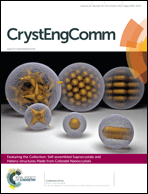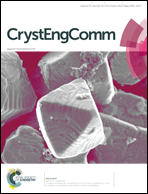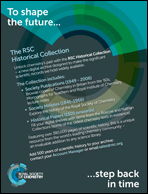Themed collection Colloidal Self- Assembled Supracrystals and Heterostructures

Self-assembled supracrystals and hetero-structures made from colloidal nanocrystals
Welcome to this CrystEngComm themed collection on self-assembled supracrystals and hetero-structures made from colloidal nanocrystals.

CrystEngComm, 2014,16, 9365-9367
https://doi.org/10.1039/C4CE90127D
Charged nanoparticles crystallizing and controlling crystallization: from coatings to nanoparticle surfactants to chemical amplifiers
Metal nanoparticles functionalized with self-assembled monolayers of ligands terminated in charged groups constitute a unique class of nanoscopic polyions – or “nanoions” in short – capable of assembling into higher-order structures.
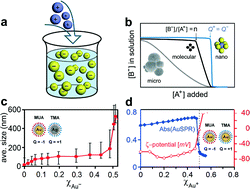
CrystEngComm, 2014,16, 9368-9380
https://doi.org/10.1039/C4CE00689E
Mesocrystalline materials and the involvement of oriented attachment – a review
In this work the oriented attachment and mesocrystal formation via non-classical pathways have been reviewed with particular emphasis being placed on their self-assembly mechanisms as well as the new collective properties of the resulting crystalline nanoparticular arrangements and their potential uses in applications.
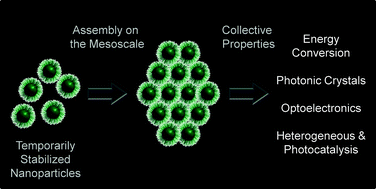
CrystEngComm, 2014,16, 9408-9424
https://doi.org/10.1039/C4CE00882K
Synthesis of copper sulphide-based hybrid nanostructures and their application in shape control of colloidal semiconductor nanocrystals
Advances in the synthesis of copper sulphide containing nanostructures and the underlying reaction mechanisms are summarized.

CrystEngComm, 2014,16, 9381-9390
https://doi.org/10.1039/C4CE00674G
Seeded-growth, nanocrystal-fusion, ion-exchange and inorganic-ligand mediated formation of semiconductor-based colloidal heterostructured nanocrystals
Various mechanisms of formation of semiconductor-based colloidal heterostructured nanocrystals have been highlighted.
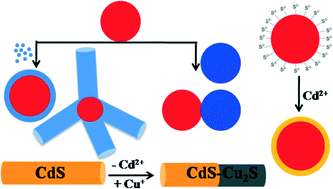
CrystEngComm, 2014,16, 9391-9407
https://doi.org/10.1039/C4CE00462K
Polymer-directed assembly of colloidal nanoparticle heterojunctions
Co-assembly of differently sized and shaped nanoparticles within a polymer matrix can be controlled to form unique nanoparticle heterojunctions.
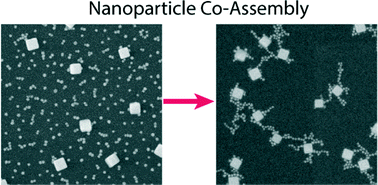
CrystEngComm, 2014,16, 9434-9440
https://doi.org/10.1039/C4CE00681J
P-type Cu7Te5 single-crystalline nanocuboids: size-controlled synthesis and large-scale self-assembly
The synthesis, shape evolution and large-scale self-assembly of p-type Cu7Te5 single-crystalline nanocuboids have been studied in this communication.
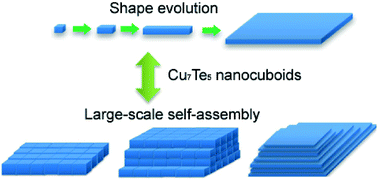
CrystEngComm, 2014,16, 9441-9445
https://doi.org/10.1039/C4CE00670D
Layer-by-layer assembly of L10-FePt nanoparticles with significant perpendicular magnetic anisotropy
The L10-FePt film has been fabricated via layer-by-layer assembly under an external magnetic field and exhibits significant perpendicular magnetic anisotropy.

CrystEngComm, 2014,16, 9430-9433
https://doi.org/10.1039/C4CE00657G
A general approach toward polymer-coated plasmonic nanostructures
A generic method for the preparation of polymer-coated plasmonic nanostructures with tunable thickness of the hydrophobic polymer spacer.
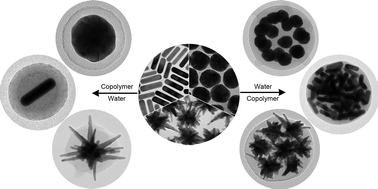
CrystEngComm, 2014,16, 9425-9429
https://doi.org/10.1039/C4CE00724G
GISAXS and GIWAXS study on self-assembling processes of nanoparticle based superlattices
The mechanism underlying the formation of nanoparticle assembly was elucidated by a GISAXS/GIWAXS study.
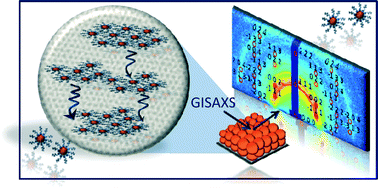
CrystEngComm, 2014,16, 9482-9492
https://doi.org/10.1039/C4CE01291G
Cation exchange of aqueous CuInS2 quantum dots
Chalcopyrite copper indium disulfide (CIS) QDs have been of recent interest due to their non-toxicity. This article shows a straightforward aqueous cation exchange method to synthesise CIS particles with zinc sulfide coating.
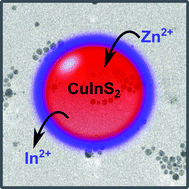
CrystEngComm, 2014,16, 9455-9460
https://doi.org/10.1039/C4CE00545G
Rhodium growth on Cu2S nanocrystals yielding hybrid nanoscale inorganic cages and their synergistic properties
Edge growth of rhodium and ruthenium–rhodium metals on highly faceted Cu2S semiconductor seeds yields a family of nano-inorganic caged hybrid nanoparticles.
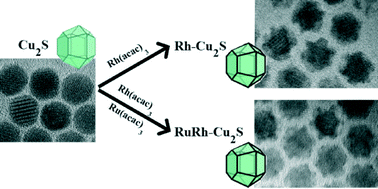
CrystEngComm, 2014,16, 9506-9512
https://doi.org/10.1039/C4CE00822G
Assembly of binary, ternary and quaternary compound semiconductor nanorods: From local to device scale ordering influenced by surface charge
In this article we outline the assembly of binary, ternary and quaternary nanorods using three separate protocols: (a) droplet based assembly, (b) assembly in a vial, (c) electrophoretic deposition. The rods are the important photoabsorbers CdS, CdSexS1−x, CuInxGa1−xS, and Cu2ZnSnS4.
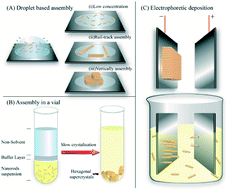
CrystEngComm, 2014,16, 9446-9454
https://doi.org/10.1039/C4CE00679H
Insight into the formation mechanism of PtCu alloy nanoparticles
What are the right conditions to form PtCu alloy NPs? A study of the formation mechanism.
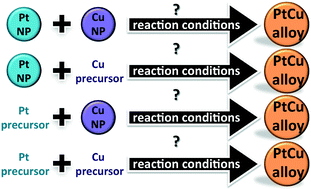
CrystEngComm, 2014,16, 9493-9500
https://doi.org/10.1039/C4CE00663A
Controllable growth of Ag2S–CdS heteronanostructures
High quality Ag2S–CdS heteronanostructures were prepared via a facile one-pot method.
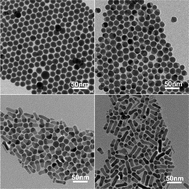
CrystEngComm, 2014,16, 9501-9505
https://doi.org/10.1039/C4CE00694A
Synthesis of ferromagnetic cobalt nanoparticle tipped CdSe@CdS nanorods: critical role of Pt-activation
Activation of CdSe@CdS nanorods by a platinum deposition reaction enables selective deposition of a single dipolar cobalt nanoparticle tip per nanorod.
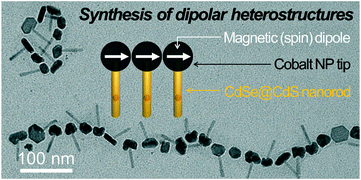
CrystEngComm, 2014,16, 9461-9468
https://doi.org/10.1039/C4CE00680A
Controlled overgrowth of Pd on Au nanorods
Controlled overgrowth of Pd on Au nanorods allows one to fine-tune the particle geometries and optical properties of bimetallic heteronanostructures.
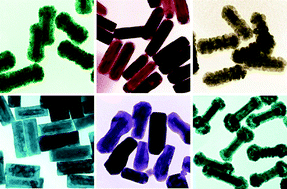
CrystEngComm, 2014,16, 9469-9477
https://doi.org/10.1039/C4CE00601A
Reversible self-assembly of MxS (M = Cu, Ag) nanocrystals through ligand exchange
Reversible self-assembly of MxS (M = Cu, Ag) nanocrystals in solution is achieved through ligand exchange.
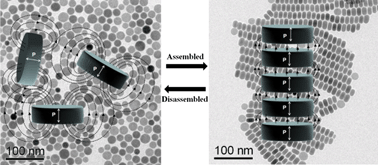
CrystEngComm, 2014,16, 9478-9481
https://doi.org/10.1039/C4CE00646A
About this collection
Colloidal nanochemistry offers the possibility of synthesising nanostructured materials that exhibit novel and/or collective properties, and have capabilities that can be exploited in multiple applications. As such, the understanding of the formation of complex all-nanocrystal-made structures from their building blocks is essential for the design of hierarchically structured materials.
Guest edited by Professor Marie Paule Pileni (University Pierre & Marie Curie), Dr P. Davide Cozzoli (CNR Nano) and Professor Nicola Pinna (Humboldt-Universität zu Berlin), this themed issue focuses on novel approaches and strategies for the assembly and the hetero-structuring of colloidal nanocrystals.
